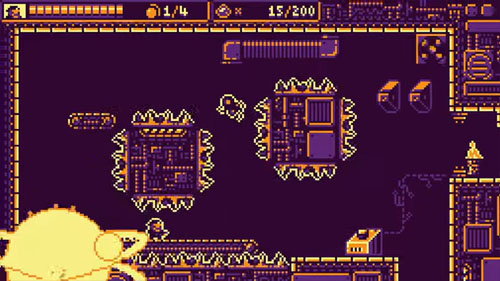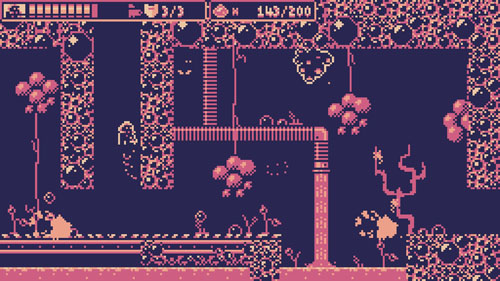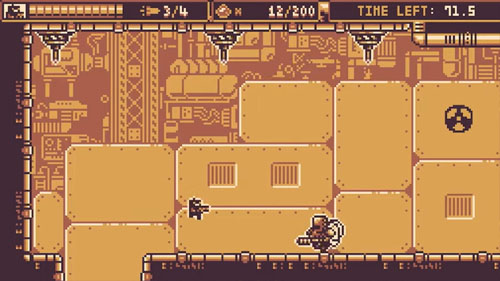A game by Small Bros for PC, originally released in 2022.
B.I.O.T.A. is an open world action-platformer set on an outbreak-infested asteroid known as Frontier Horizon. The outbreak appears to be alien in origin – possibly a virus or a fungus – but one thing’s for certain… it’s extremely dangerous. To combat this threat and rescue a top scientist trapped somewhere on the asteroid, the Gemini II unit is sent in, setting down outside the entrance to a mining complex with a 4-person squad, each of whom has a different specialty... but all of them specialize in aiming their hot bullet nozzles at anything ugly, which is good, because that’s exactly what the situation demands.The game starts off with a short escape sequence, giving the player a chance to try out the controls, and this also acts as a preview of the game’s finale. Following this introductory stage, the player is free to wander around the asteroid’s surface, speaking with the people stationed there and learning more about the dangers ahead. For one thing, the nuclear reactor that powers the facility has been inaccessible since the start of the infestation, and it’s at risk of going critical. There are also multiple areas that have been sealed off, making them inaccessible until the player acquires the necessary items to reach them.
This hub area also features a save point, a robot that restores your health, an elevator to access any areas that you have unlocked, a black market shop (although it’s hardly subtle, as it occupies a freestanding building with a flashing “black market” marquee), and a training facility. The training facility lets you run through a small area, shooting targets and enemies, with a cash reward based on your speed. However, if you are killed, you get booted out and have to wait for the simulator to recharge before you can try again. Skilled players can use the facility to quickly max out their currency – an element known as viridium – although it also appears in large quantities during regular gameplay.
The hub area also allows you to interact with your squadmates, and select between them. Each member of the squad carries different primary and secondary weapons, offering different rates of fire, accuracy, and power. Secondary weapons have limited ammo, which occasionally appears in drops from destroyed enemies or objects, along with viridium chunks of varying denominations. Some destroyed objects drop medpacks that restore a few units of health, but these drops are quite rare.
At the start of the game, the player may select between four playable characters: Lieutenant Kirill carries a medium range thermic gun and C4; Private Zeed has a powerful short range shotgun and a force field; Captain Ace has a machine gun with a high firing speed but low power, along with grenades; and finally, Private Flynt wields a long range rifle with low power, along with a sniper shot that allows him to take down enemies anywhere in the room. There are also four additional playable characters to be unlocked.
While your weapons and special abilities differ based on the selected character, each of them has the same movement abilities. This includes a 2.5x nonvariable jump, the ability to shoot to the left or right while running, jumping, or standing, and the ability to shoot upward while standing or jumping. In addition, you are able shoot down most enemy projectiles.
You can perform a wall slide, wall jump, and a triangle jump, and you are able to jump up vertical surfaces, although you cannot shoot while sliding. Unfortunately, it is impossible to grab a ledge once your falling speed increases past a certain point, and you will automatically start to fall once you’ve slid a certain distance down a wall. This operates counter to most games with this feature – where you can always slide when touching a wall and do not automatically disconnect – which can make the wall slide feel unresponsive at times.
At the start of the game, you have 8 units of health, but this can be upgraded a little at a time throughout your adventure as you discover additional black market shops. Checkpoints appear infrequently, and while the game promises that you can save when you want, this can only be done in cleared rooms. As a result, you may lose significant progress when you are killed, resulting in fair amount of replayed sections. Your health is not restored when activating or reloading checkpoints, but you always have the option to warp back to base if you find yourself overwhelmed, where you can heal, save, or swap over to another character.
Skilled players should have little trouble working their way quickly through the first half of the game, as enemy behaviors are simple, and most pose little threat to veteran shootists. However, as the game goes on, you will encounter more and more insta-death traps, as well as mines and explosive projectiles that can knock off half of your health in one hit. Your invincibility period is also extremely short, so it’s possible to take multiple hits in rapid succession.
Your health meter is increased by one unit for each nanotech injection you purchase, and you can also purchase additional ammo slots for your special weapon, and unlock another unique special weapon for each playable character. Black market shops also gate your progress, as you need special items in order to proceed, but each shop offers different wares, and required items steadily increase in price. As such, your ability to explore the world is controlled by purchasing or collecting items for your inventory rather than unlocking new abilities.
At the start of the game, you can only carry 100 units of viridium, and right away you encounter a shop with an item exceeding that amount. Throughout the game, you encounter containers that increase your maximum viridium storage by 100 units each, up to a maximum of 1,000. This means that you’ll need to thoroughly search each area to ensure that you haven’t missed anything, lest you find yourself backtracking in search of an errant container.
A detailed map shows the outline of every room in the game from the start, and most of the world is comprised of interconnected single screen rooms. Map outlines are filled in as you enter each room, displaying the possible exits and highlighting key objects such as elevators, switches, and shops. If you reach an impasse, it’s a good idea to check the map for any rooms you may have missed, and the game always informs you which item is needed to move forward.
In a nice touch, shops display their key items on the map, so you know which shop you need to revisit. You are also free to teleport back to your home base at any time, and from there, you can use an elevator to reach any other elevator access point you have encountered, allowing you to quickly move around the map, and removing some of the tedium of backtracking.
Right out of the gate, the game offers a pretty good feel for the amount of exploration required, offering several rooms in succession that have multiple exits, with no indication as to which is the best path forward. The player may find himself looping back over his own path as he runs from room to room, but eventually he’ll reach one of three possible exits to new areas. One exit leads to the aforementioned nuclear reactor, but the player is informed that he needs a robot due to high levels of radiation, and another area can only be traversed with a mech suit.
In the case of the critical reactor, the player is given a countdown timer and he must move quickly through the area while dealing with enemies and traps in order to reach the reactor and shut it down. In the case of the mech, the player must complete several linear sequences where he clomps his way through enemy-infested corridors, blasting them with an endless array of missiles (with a short pause to reload). Unfortunately, the mech sequences are not very technical affairs, offering simple left-to-right gameplay where the player just walks and shoots while soaking up some largely unavoidable damage along the way, which is then fully healed by collecting wrenches. One sequence ends with the player running from an ever-advancing laser, although this translates to the same keep-walking-and-shooting gameplay as before.
The same is true for the game’s short vertical shmup sequence where the player flies through fields of asteroid and enemies, blasting everything in his path. New weapon drops appear frequently (drop types are random), but gameplay isn’t complex enough that any one weapon gives you an advantage over the others. Getting hit knocks you back down to your pea shooter, but that’s a rarity given how easy it is to avoid damage. With a 5-way shot, you can pretty much park yourself at the bottom of the screen and blast a path to victory, only occasionally needing to move your ship.
A submarine section offers a bit more complexity, as the player moves through rooms filled with enemies and mines, using a quickly-refilling bank of missiles to take them down. This sequence is almost entirely exploration based, as the player must find generators that control gates blocking his progress… but the entire sequence is just generators and gates.
While the vehicle sequences change up the gameplay a bit, the game’s strength is in its on-foot sections, where the action remains pretty fast throughout, interspersed with bits of technical platforming and harrowing insta-kill trap avoidance. Each area offers a few unique enemies, obstacles, and traps, and making an effort to traverse each path almost always yields some reward. Several genre staples make an appearance, such as conveyor belts, moving platforms, high jump platforms, pools of lava, electrical barriers, and switches. But there are a few twists to be found, such as the organic infestation populating certain areas, conveyor belts containing exploding barrels, and areas where floating environmental debris acts as platforms.
There’s also a face hugger-style enemy, which jumps on your head and transforms you into one of the enemy creatures, which is a nice touch. In most game where you’re told that people have been taken over or transformed by something, there’s not any actual risk of it happening to you. Sure you can be killed, or get a fade to black where you’re told that you’ve succumbed like the others, but it’s interesting to see the game actually show your body being transformed into one of the enemies you’ve been fighting… which enforces the fact that those enemies were actually people at one point.
There are also specimens to be found, some in hard-to-reach areas and others hidden behind destructible walls. These specimens – there are 30 in all – each unlock a different color palette for the game, although there are quite a few palettes available from the start as well.
Of course, there are a few bosses as well, most of which involve avoiding their attacks while unleashing as much damage as possible, and most are grotesque in appearance. The serpentine boss in particular demonstrates a few different movement patterns where it occasionally emerges from the water to deliver a couple of different attack types.
The first boss, on the other hand, is a bit tedious, requiring that the player run back and forth above a creature, occasionally dropping explosives into its mouth, and repeating the process five times before the fight ends. Fortunately, all of the later bosses are more engaging.
The game offers chunky retro-style visuals with white outlines around the character and enemies, a very limited color palette, and a synth-style soundtrack. There are plenty of effects to be seen as well, from explosions to particles to puffs of smoke, along with a bit of screenshake (which can be disabled). The effects work and colors can occasionally make it difficult to tell what’s going on, but overall it enhances the fast-paced action. There’s a ton of dialogue that appears intermittently throughout the experience, so players can take the time to learn more about what’s happening, or skip over it to get back into the action. The game offers two possible endings, and also a score-based shooting gallery and a linear time attack mode.
2D CRED
B.I.O.T.A. was developed by Small Bros, a one-person studio founded in 2015 and based in Italy. The studio is headed by Ivan Porrini, who previously developed Ghostly Matter and who has done work for Milestone s.r.l. Music for the game was composed by Maxim Tolstov (a.k.a. JPEG).
The game was published by Retrovibe, the publisher behind the Project Warlock and Janosik series, The Looter, and Shardpunk: Verminfall. The studio was founded by Michal Kicinski, who worked previously on the Witcher series at CD Projekt Red, along with Michał Affelski and Krzysztof Papliński, who also founded indie publisher GamingCompany (Project Warlock, Warsaw).




































0 comments:
Post a Comment